Abstract
The classical nucleation theory for immersion freezing was used for the simulation of ice nuclei particle activation under atmospheric conditions. A modification of the surface diffusion energy was introduced that was based on the concept of a two-dimensional diffusion of the adsorbed molecules on the surface of the substrate. Comparison with available laboratory data for kaolinite dust and bacteria cells were performed and qualitative agreement of ice nucleation onset was found. Simulations were performed for specific airborne microorganisms including P. syringae. Additionally, model simulations were performed for a set of 140 different bacteria. Model simulations showed that bacteria activation occurs in the atmosphere, which may be enhanced at lower temperatures. Increasing pre-existing available surface for ice nucleation resulted in higher nucleation probability in agreement with experimental observations. The current study showed that a critical parameter for the determination of IN is the value of the contact angle between the substrate and the critical cluster. Comparison with available parameterizations for P. syringae and dust particles was also performed, and classical nucleation theory showed similar nucleation rates in the temperature range of laboratory experiments from which the parameterizations were derived. In addition, a correction factor to bulk surface tension was applied for small ice clusters. Higher nucleation rates were calculated from this correction by a few orders of magnitude but their effect on nucleation probability was not significant. The classical nucleation theory is based on physical principles and can be further incorporated in General Circulation Models to determine the IN activation in the atmosphere for a mixture of different pre-existing particles including bacteria cells and dust.
1. Introduction
Cloud formation is an essential component of the climate system, and their dynamics are directly linked to the earth’s radiative balance and hydrological cycle [1]. Even though the importance of clouds is crucial in the understanding of climate dynamics, some aspects of their formation, such as the initial formation of ice nuclei, remain still not very well understood. The formation of ice inside clouds has an influence on cloud radiative properties and therefore indirectly on weather and climate [1,2]. Inside tropospheric clouds, the water partial pressure is higher than the saturation vapor pressure in relation to ice and the temperatures occurring are lower than the ice melting point, and are defined as supercooled temperatures. Cirrus clouds, which cover close to 30% of the Earth’s surface, are especially important in the global radiation balance [3].
Ice formation in clouds can occur through different ice nucleation mechanisms. Heterogeneous ice nucleation may occur through different mechanisms, which are the deposition, condensation, immersion, and contact modes [2]. In the immersion mode, the ice nucleation (IN) starts immersing inside the droplet, which is in contact with a pre-existing particle at temperatures warmer than 0 °C. This process makes the immersion mode a very important pathway for IN in the atmosphere which occurs at warmer temperatures than the other modes.
Field measurements have shown that the occurrence of ice nuclei (INP) is rare compared to the formation of cloud condensation nuclei (CCN) [2]. Laboratory and field studies also revealed the ability of dust particles and microorganisms to act as INPs [1,2,3,4,5,6]. Among different microorganisms, Pseudomonas syringae has a very good ice nucleation potential [7,8]. The dependence of ice nucleation on surface coating was studied by, among others, Chernoff and Bertram [9], and they found that the H2SO4 coating of mineral dust particles leads to an increase in the contact angle. However, no effect was observed applying a surface coating to SNOMAX (cells of P. syringae).
Different approaches have been used to describe the mechanism of immersion freezing nucleation. Alpert and Knopf [10] described the variability of ice active sites on the surface of the pre-existing particles that act as ice nuclei. A stochastic model was introduced that accounted for variable INP surface area to reproduce the time and surface area in relation to immersion freezing experiments. Kaufmann et al. [11] suggested corrections to the heterogeneous classical nucleation theory (CNT) introducing a pre-factor to the rate coefficient of the nucleation rate as a second parameter in addition to the contact angle to interpret refreeze experiments with water droplets. A factor that has also been studied in CNT is the effect of elastic strain introduced in an ice embryo arising from the misfit between the ice and the substrate lattice of the pre-existing particle [2,12].
Furthermore, Chen et al. [13] were able to parameterize the main components of the classical ice heterogeneous nucleation rate using laboratory data for different substrates such as soot and specific bacteria. The contact angle was recognized to be the most important free parameter of the theory. In addition, Hartmann et al. [14] developed a simple parameterization for the determination of the nucleation probability of P. syringae in the temperature range between −5 °C and −38 °C.
Wheeler and Bertram [15] studied experimentally the deposition nucleation on mineral dust particles and found that CNT using a single contact angle does not fit the whole range of data. They proposed a distribution of contact angles and a model of active sites to fit the experimental data as an alternative approach. The determination of contact angles for several mineral components was also reported by [16], which can be further used in atmospheric simulations.
Furthermore, Sahyoun et al. [17] applied a number of parameterizations for the determination of the nucleation ice probability of bacteria in the atmosphere and their further use in climate models. Their sensitivity to input parameters was considered high, and the authors recommended a careful assessment of the number of INP bacteria for evaluating their impact on cloud formation and climate. Alternative parameterizations were also proposed in the literature such as the work by Ullrich et al. [18]. They found large deviations with respect to the ice deposition nucleation derived from CNT.
Parameterization for immersion freezing on desert dust particles was developed by Niemand et al. [19] (2012) based on cloud chamber measurements. Fan et al. [20] applied a temperature-dependent parameterization for immersion freezing in mixed-phase clouds. Primary biological aerosol particles, which are first activated as CCN, can further act as INP [21,22]. However, particles that can serve as INP may differ from those acting as CCN. INPs have similar bonding to ice and usually are insoluble in water [1].
Vertical mixing in atmospheric models has to implement detailed microphysical modeling including a reliable model for CCN and IN formation. The use of CNT in General Circulation Models (GCMs) with appropriate detail for the contact angle values, even though this requires extensive computation time, allows a reliable physical description of the activation processes based on the theory of first-order phase transitions. A numerical study of contact angle parameterization for immersion freezing was performed by Ickes et al. [21] using CNT. Similar parameterizations for different minerals were adopted for use in GCMs. However, Hummel et al. [23] showed in simulations using the COSMO-ART model that the effect of primary biological particles on the formation of ice crystals in clouds was not significant due to their low atmospheric concentrations.
In the current work, CNT for ice immersion freezing was applied to study IN activation, including airborne microorganisms and dust particles. A correction factor to bulk surface tension was applied for small ice clusters, as well as a new approach for surface diffusion. CNT is a powerful methodology that can provide a realistic simulation of IN activation in atmospheric conditions.
2. Theory of Nucleation
Theory of Immersion Freezing—Mathematical Formulation
IN activation during immersion freezing in the atmosphere can be described with the use of the classical theory of ice heterogeneous nucleation as described by [2]. The heterogeneous ice nucleation rate Jhet (embryos −2 s−1) can be expressed as:
where kB is the Boltzmann constant, h is the Planck constant, T is the temperature in Kelvin (K), and n is the number density of water molecules at the interface between the water and the critical ice nucleus. In the current study, we have adopted a value of n = 5.85 × 1018 m−2 [2]. In addition, ΔFdiff is the diffusion activation energy for a water molecule passing the water–ice interface. The ΔFdiff can be expressed as [24]:
where E = 892 K and To = 118 K.
An alternative approach to determining the diffusion activation energy can be based on the concept of the adsorbed molecules on the surface of the substrate as a two-dimensional solution [25,26,27] incorporated a diffusion coefficient D (D = δ2/(4 τD)) for the movement of molecules on the surface of the substrate, where δ is the mean jump distance and τD the average jump time from site to site. The thermal motion of the molecules is similar to the motion of particles in an ordinary three-dimensional liquid. In the calculation of the nucleation rate the number of molecules that impinge on an embryo per unit time is given as [26]:
where the number concentration of adsorbed molecules can be expressed as (molecules/m2), is the average velocity of the adsorbed molecules on the surface of the aerosol particle; and , where m = cos(θ), m is the contact parameter, θ refers to the contact angle of the ice embryo on the pre-existing particle, r is the radius of the embryo, and Rp is the radius of the aerosol particle [26]. The function τ refers to the time that a molecule spends on the surface of the solid particle, given by , where Eo is the latent heat of fusion. The characteristic time scale τo is the inverse vibrational frequency of two harmonically-bound molecules (), where U is the Lennard-Jones intermolecular interaction potential and mμ is the reduced mass [26].
In addition, ΔG(T) is the Gibbs free energy for the formation of the critical embryo and can be expressed in CNT as:
where r* is the critical radius of the embryo and γsl the surface tension between the ice and the liquid phase.
The ice cluster radius that includes i* molecules is given by:
where υ is the molecular volume of water in ice and is the difference of the chemical potentials between the ice phase (cluster) and the liquid phase and is related to the ice saturation ratio.
In addition, the factor f(m,x) is expressed as:
A more practical indicator for the determination of IN activation in the atmosphere is the nucleation probability which refers to the probability of an ice embryo appearance [28,29]:
where τ is the time period in which the IN activation is studied. A value of 1 s was used in this study. This is the lowest time interval, as activation processes in the atmosphere may last quite longer. However, the activation process is mainly governed by the nucleation rate values. The activation probability in the case of thermodynamic theory has a similar expression with the replacement of the nucleation rate J with the activation rate constant k as shown also in the above equation. In the calculations performed in the current work the formulation for the nucleation rate using the new approach for the surface diffusion was adopted.
Figure 1 shows the temperature variation of the Gibbs free energy (ΔG) for embryo formation and the diffusion activation energy (ΔF). A considerable decrease in the Gibbs free energy is calculated using CNT at lower temperatures. Ickes et al. [21] reported values of ΔF close to 5 × 10−20 Joules, which is in agreement with the predictions using the parameterization of Zorbist et al. [23], which is used in the current study. Chen et al. [13] also reported values for ΔF close to 12 × 10−20 Joules. Pruppacher and Klett [2] also provided experimentally determined temperature-dependent values for the diffusivity of water molecules in bulk water; and a sensitivity study for the calculation of heterogeneous nucleation was provided by [22]. Furthermore, Ickes et al. [21] showed a number of parameterizations used for the evaluation of the physicochemical properties in CNT for the calculation of ΔG in the range of 230 K–260 K. The range of values ranged on average from 10 to 120 × 10−20 Joules. Similar behavior is shown in Figure 1 based on the current application of CNT. At lower temperatures, there is a decrease in ΔG leading to easier ice formation and therefore to IN activation.
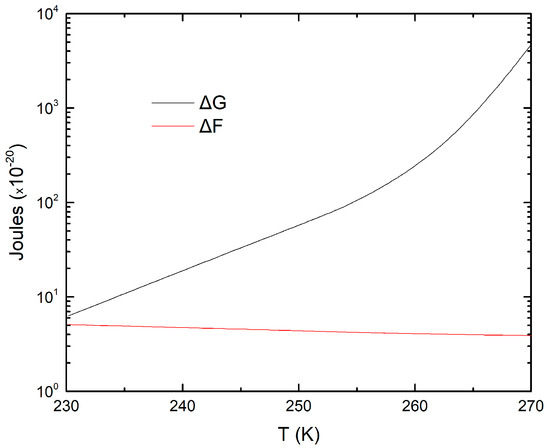
Figure 1.
Variation of the Gibbs free energy (ΔG) and diffusion activation energy (ΔF) (Joules) with ambient temperature.
Figure 2 shows the combined conditions occurring among the radius of the pre-existing particle and temperature for IN activation. The simulations were performed for soot particles (θ = 48°; mean size range: 40 nm; [30]) and P. syringae bacteria (θ = 20°; mean size range: 5.8–22.8 μm; [9]). Activation of P. syringae occurs at higher temperatures compared to soot particles, arising from the lower contact angle values. The good IN nucleation potential of Pseudomonas syringae has been reported in several other studies [7,8]. With decreasing ambient temperature, the probability of IN activation increases due to the lower required energy for the formation of the critical clusters, and therefore IN formation occurs at a smaller particle radius.
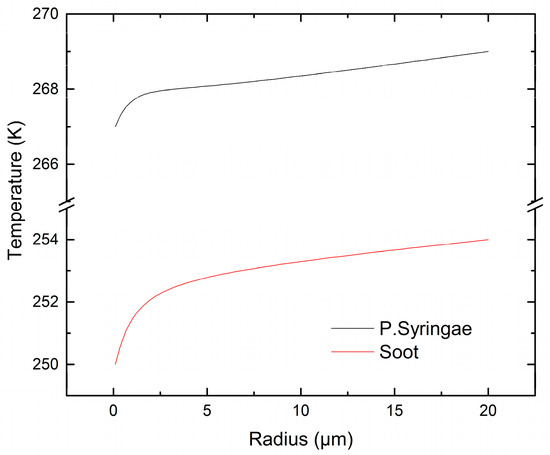
Figure 2.
Relationship between ambient temperature (K) and radius of pre-existing particles (μm) at IN activation conditions.
A comparison between IN CNT and the experimental data of Welti et al. [31] for kaolinite dust is presented in Figure 3. Different values of the contact angle were used for the CNT simulations. Higher probability values per surface area were observed at lower temperatures in qualitative agreement with the predictions of the nucleation theory. Using a single contact angle as the fitting parameter in the CNT model, it was possible to predict the general dependence of the nucleation probability versus temperature but there are considerable differences with the experimental results. In addition, the classical theory predicts a steeper descent in the nucleation probability versus temperature. The possibility that different particles have different adhesion potentials with ice embryos is proposed for more closely simulating the experimental results for different pre-existing particles [20] giving better agreement. However, fluctuations in temperature and relative humidity values in the atmosphere may compensate for this variability. In addition, it is very difficult to determine the possible distribution of contact angle values for the same particles, as well as the distribution of active sites. Furthermore, the data from Welti et al. [31] showed an increase in the nucleation probability with an increase in the particle radius of the pre-existing particles in qualitative agreement with the predictions of CNT.
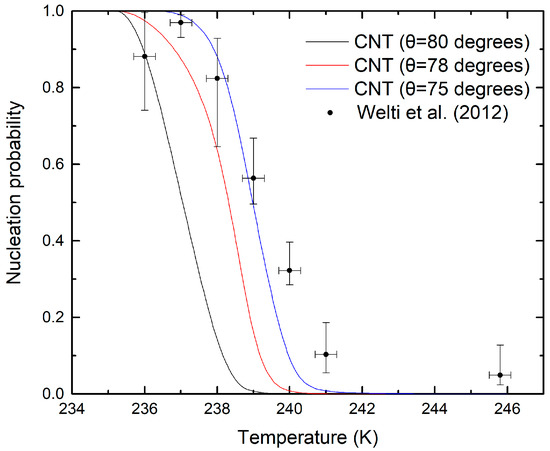
Figure 3.
IN nucleation probability per surface area versus temperature for kaolinite dust using the classical nucleation theory with different contact angles and comparison with the laboratory data of Welti et al. [31].
Another approach using a Gaussian distribution of contact angles in heterogeneous ice nucleation calculations was adopted by Marcolli et al. [32] to better describe the laboratory experimental results for different substrates. A similar approach was adopted by Welti et al. [31] and Wright and Petters [33]. In addition, Wang et al. [34] used a number of contact angle distributions for the simulation of ice nucleation in a global climate model. A better agreement with observations was achieved at temperatures above −20 °C using a distribution model of contact angles.
A further comparison with bacteria samples is presented in Figure 4, using two different contact angles. The contact angle of 14.82° was adopted from [6] to better fit the laboratory data of ice nucleation from single ice nucleation bacteria cells (Yellow pigmented isolate (strain M1) from Israel) measured by Yankofsky et al. [35,36]. The variability introduced using another contact angle (θ = 16°) is shown also, which results in a nucleation onset at a lower temperature. CNT using specific values for the contact angle was able to qualitatively reproduce the temperature dependence of the experimental data for bacteria cells, as shown in Figure 4, versus the nucleation probability, even though the differences in the actual nucleation rate are large. A simulation using a log-normal distribution of contact angles adopting the approach of Wang et al. [34] was also used (mean contact angle θ = 13.6° and standard deviation σ = 0.2). However, the deviations between the experimental data and CNT are large for temperatures above 271 K for this specific set of bacteria cells.
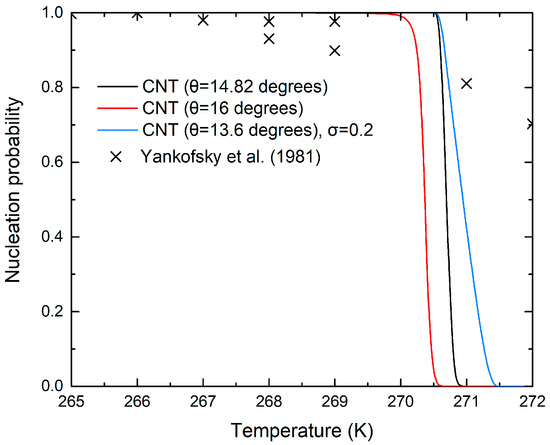
Figure 4.
IN nucleation probability versus temperature for bacterial samples (M1, rp = 750 nm) using different contact angles, a log-normal distribution of contact angles, and comparison with the laboratory experimental data of [35,36].
3. Results and Discussion
3.1. Ice Nucleation Simulations at Atmospheric Conditions
CNT ice heterogeneous nucleation for immersion freezing was applied here to simulate IN formation in the atmosphere for bacteria using vertical profiles of temperature from Hamill et al. [37]. As discussed previously, P. syringae is a common ice nucleus [9] in the atmosphere and also a potential candidate for CCN formation at lower altitudes [21]. The ice heterogeneous nucleation rate (embryos/(m2 s)) for two common bacteria in the atmosphere, P. syringae, and P. aeruginosa, was studied, and a mean bacteria radius of 0.3 μm was used in the simulations. The contact angle values used in the simulations were 20o and 106o for P. syringae and P. aeruginosa, respectively [9].
Model simulations predicted that at higher altitudes (6–8 km) P. aeruginosa bacteria have a high nucleation rate (102–104 embryos m−2 s−1), which is mainly attributed to the lower temperatures occurrence, which drastically influences the Gibbs free energy of formation in the critical cluster. At such low temperatures, the size of the critical ice embryo is a few nanometers, and, therefore, ice formation is mainly influenced by the diffusion activation energy [25]. The former refers to the activation of single particles and there is no consideration of the fact that there is a decrease in the concentrations of INPs with height in the troposphere. This is due to the fact that the majority of INPs have an origin at the Earth’s surface. Above the height of 8 km (mean temperature of −38 °C) it is known that homogeneous freezing nucleation dominates over heterogeneous freezing by INPs.
Simulations were also performed for the determination of IN formation for bacteria of a radius of 0.3 μm (θ = 20°) using the two approaches for the calculation of the diffusion activation energy. The first approach of Zorbist et al. [23] uses the diffusion activation energy for a water molecule passing the water–ice interface. The second approach [25], to determine the diffusion energy using the concept of the two-dimensional liquid solution was used in the current simulations and resulted in higher nucleation rates compared to the approach of Zorbist et al. [23], as shown in Figure 5. Sensitivity analysis of the effect of the different approaches used in CNT for the determination of the diffusion activation energy reveals considerable differences for the nucleation IN potential. However, both approaches showed a similar probability of ice nucleation in the atmosphere for small contact angles.
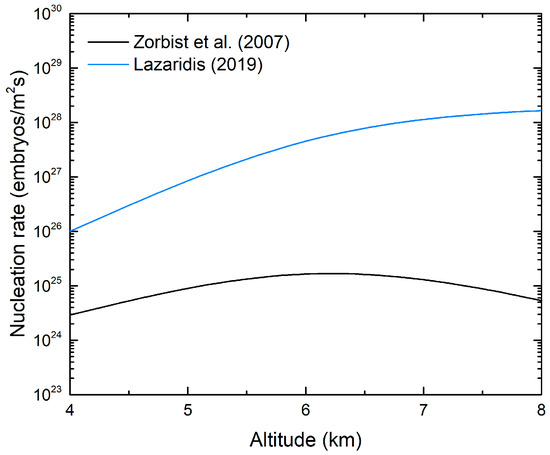
Figure 5.
Ice nucleation rate (embryos m−2 s−1) for immersion freezing versus altitude (bacteria radius equal to 0.3 μm, θ = 20°) using two different approaches for calculating the activation diffusion [22,24].
There is a high IN nucleation potential of P. syringae bacteria as reported in several studies in the literature [9], as well as a potential to act as cloud condensation nuclei (CCN) [38]. The possibility of heterogeneous IN of P. syringae was studied at different contact angle values, which remain the main factor controlling their activation at ambient temperatures occurring at the middle troposphere (T = 263 K and T = 253 K), as shown in Figure 6. These temperatures occur at altitudes between 0–4 km in the troposphere. The probability of IN activation is higher at lower contact angles and the nucleation potential increases with decreasing temperature. The activation of P. syringae is favorable at low contact angles for both temperatures, and at the lower temperature (T = 253 K) the activation occurs at contact angles close to 60°, which are higher than the representative contact value of 20° [9]. These results reveal the high activation potential of P. syringae bacteria in agreement with experimental studies on its high ice nucleation potential [9].
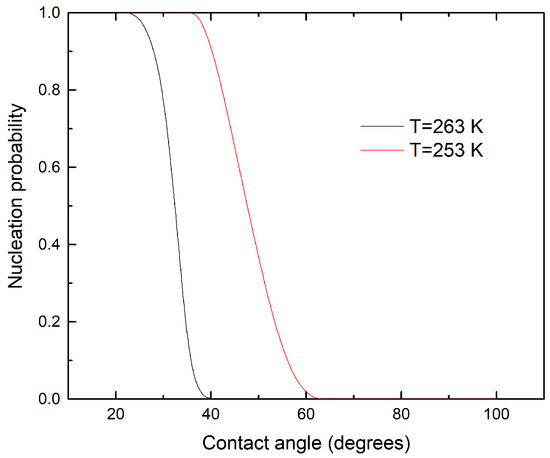
Figure 6.
Ice nucleation probability versus contact angle of Pseudomonas syringae bacteria (rp = 0.3 μm) at ambient temperatures of 263 K and 253 K.
The surface area of the pre-existing particle for IN formation through immersion freezing was studied in the literature recognizing the effect of the total ice active surface area [2]. Beydoun et al. [39] calculated the total active surface area in their experiments as equal to 6 nm2 using CNT. The available surface area for ice nucleation is related to the nucleation probability, as shown in Figure 7. The simulations were performed at temperature conditions for a 6-km altitude (T = 248–249 K) with a contact angle θ = 55°. Higher activation occurs at lower temperatures and the increase in particle size results in an increase in the nucleation probability. In the atmosphere, an increase in the available surface area of specific particle types may result in a considerable change in ice nucleation probability. This sensitivity analysis is related to a potential temperature increase in the atmosphere through climate change. Even a temperature increase of one degree will result in considerable changes in the ice nucleation potential of the atmosphere, as shown in Figure 7.
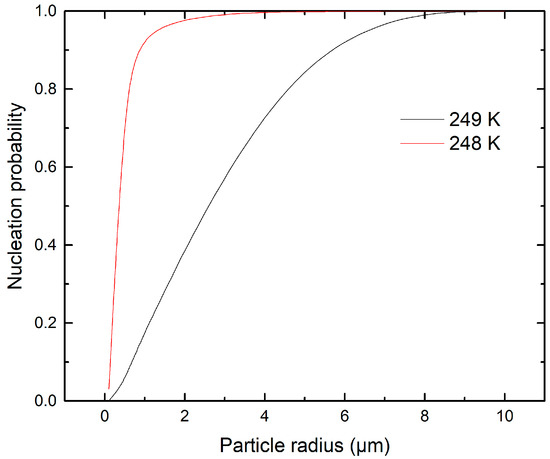
Figure 7.
Nucleation probability versus particle radius of the pre-existing particle at an altitude of 6 km (T = 248–249 K, contact angle θ = 55 degrees).
A realistic simulation of bacteria in the atmosphere has to incorporate detailed information on the presence and abundance of different bacteria and their physicochemical properties, including laboratory data on their adhesion properties. A reference sample of such data for the present study was obtained from Sharma and Rao [40]. In their review article, they summarized contact angle data from 140 bacterial cell surfaces with water with contact angles ranging from 16o to 106° with a higher frequency of hydrophilic bacteria corresponding to low contact angles. The isolates were derived from ATCC and NCTC strains and other standard strains in hydrophobicity research.
The IN probability at different ambient temperatures was also studied for the distribution of bacteria cells (mean bacteria radius, rp = 1 μm) as described by Sharma and Rao [40]. The use of the specific distribution of contact angles is mainly to show the effect of such distribution on the activation of INP even though the experimental data refer to values of contact angle on substrates and not to contact angles of ice embryos immersed in water. In the atmosphere, there is a taxonomic composition of bacteria that follow the global cycling of materials in the Earth’s atmosphere. A better understanding of the bacteria taxa distribution and their activation will provide the scientific community with valuable information on climate research.
At temperatures above 262 K (below 4 km) the predicted IN activation is not significant due to the temperature conditions (Figure 8). At higher altitudes IN probability ranges from 0.5 at 262 K (4 km) to 0.9 at 236 K (8 km). At lower ambient temperatures, the bacteria activation is more efficient due to a lower required Gibbs free energy of formation for the ice embryo.
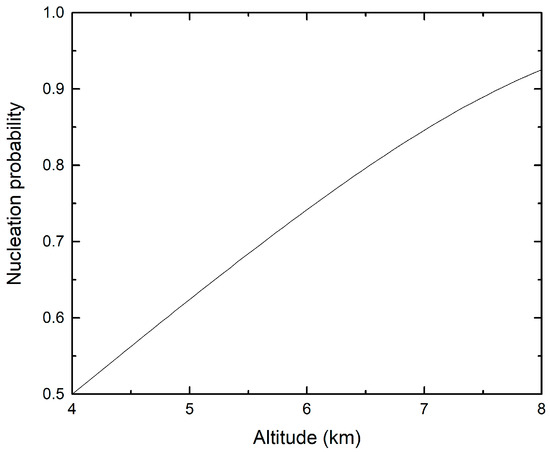
Figure 8.
Ice Nucleation probability of 140 bacterial cells distribution [40] at different altitudes.
3.2. Ice Nucleation Parameterizations
Ickes et al. [20] presented a sensitivity analysis of CNT for immersion freezing, recognizing the importance of contact angle for the prediction of the nucleation rate. The current work also highlights the importance of the contact angle and the diffusion mechanism for the evaluation of the ice nucleation probability. Parameterizations arising from this analysis may be incorporated into GCMs.
The difficulty in implementing the CNT model of ice immersion freezing in GCMs due to the need for extensive computer CPU time resulted in the implementation of nucleation parameterizations based on laboratory measurements [14,41,42]. Hartmann et al. [14] provided a parameterization for P. syringae at temperatures from −5 oC to –38 °C from laboratory data on immersion freezing at an active protein complex. The nucleation rate (s−1) can be expressed as:
where, TC = T –T0 (T0 = 273.15 K)
In addition, the nucleation rate (embryos m−2 s−1) for soot and dust were expressed as [17,43]:
Comparison of the above parameterizations with the ice CNT for immersion freezing of P. syringae revealed that both CNT and the parameterization applied to predict quite close nucleation rates for altitudes up to 6 km. At 5 km, both CNT and the parameterization predicted 1024 embryos m−2 s−1, which corresponds to a nucleation probability of 1. The temperature range across which the parameterization of [14]) is valid applies to altitudes up to 5 km. At higher altitudes, the applicability of the parameterization is not valid. However, the factor that determines the activation of IN is the nucleation probability, which has a value of 1 at altitudes above 6 km for the P. syringae bacteria, as revealed by the simulations above for both CNT and the parameterization used.
CNT was also compared with a parameterization for dust particles [43] using a contact angle of 46° [42,44] versus height in the atmosphere. Simulations were also performed for soot particles using CNT adopting a contact angle of 48° [42]. A more detailed study of fitting parameters for different kinds of dust using CNT was provided by Ickes et al. [20] and Boose et al. [45]. These studies presented comprehensive datasets of immersion freezing for several natural dust types from deserts worldwide. At 5 km, both CNT and the parameterization predicted 104 embryos m−2 s−1, whereas for a height of 8 km their predictions were 1010 embryos m−2 s−1 for both approaches.
3.3. Contact Angle Parameterization
A more significant influence than local fluctuations of meteorological parameters on the ice nucleation rate may arise from uncertainties related to the value of the contact angle. This is recognized in the literature and a Gaussian distribution of contact angles was used by Beydoun et al. [39] (2016) to determine the surface of ice active sites derived from droplet freezing spectra. Pruppacher and Klett [2] also discussed the importance of active sites in IN activation but their quantification at different substrates remains a challenge in determining their importance to contact angle values.
An alternative approach for determining changes in contact angle values was presented by [46]. The authors introduced a correction of the bulk surface tension of an embryo comprising of i molecules that eventually results in changes in the contact angle values. This is important, especially in cases where the critical cluster is comprised of few molecules. The correction factor ki for the bulk surface tension of a cluster comprised of i molecules was evaluated as:
where α1 and α2 are parameters that are determined from the equation of state. The factor ki is also a function of temperature and the saturation vapor pressure of water.
For a dimer the expression for the correction factor can be written as:
where B is the second virial coefficient, ps is the water saturation pressure and . The term A1 refers to the surface area of a monomer and kB is the Boltzmann constant.
The effect of the surface tension correction on the nucleation rate at altitudes between 6 km and 8 km for the nucleation rate during immersion freezing (rp = 1 μm, θ = 60°)) is shown in Figure 9. The effect of the correction factor is prominent at altitudes up to 2 km, where IN activation occurs only in the case that the modified value of the surface tension was used with a predicted nucleation rate of 106 embryos m−2 s−1.
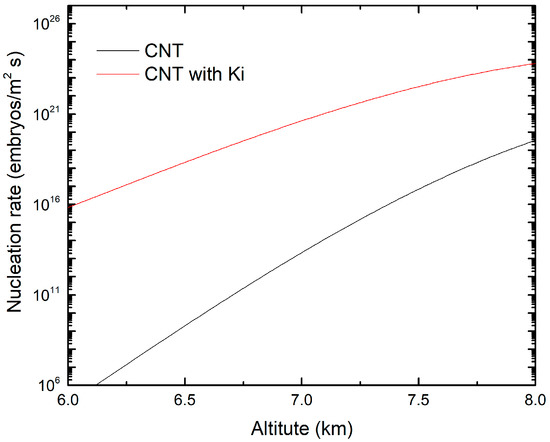
Figure 9.
Nucleation rate (embryos/(m2 s)) versus altitude in the atmosphere using CNT and a revised CNT theory including a surface tension correction factor during immersion freezing for pre-existing particles (rp = 1 μm) with a contact angle θ = 60°.
Another correction to the bulk surface tension was introduced by [47] as:
where r is the radius of the embryo and δ is a correction factor that arises from the microscopic discontinuity between the embryo and the liquid phase for the ice nucleation case. The term γ refers to the bulk surface tension, whereas the term γmicroscopic refers to the corrected value of the surface tension. Tolman [47] showed an increase in the nucleation rate due to the correction of the bulk surface tension. Laaksonen and McGraw [48] derived a correction to Tolman’s expression that, however, showed a similar effect to Tolman’s theory.
4. Conclusions
CNT for ice immersion freezing was applied for the simulation of airborne microorganisms, dust, and soot particles in the atmosphere. CNT was able to reproduce qualitative laboratory data for kaolinite and bacteria samples using different values of the contact angle. The ability of CNT to reproduce the experimental curves using a distribution of contact angles was also discussed. Simulations were performed for the activation of different bacteria using laboratory-determined contact angles, highlighting the efficiency of the theory to be used in GCMs.
Simulations were also performed for a set of 140 different bacteria. These simulations concluded that the IN activation approach has a good potential for a number of bacteria. Immersion freezing is a possible nucleation mechanism also for dust particles. This mechanism is especially related to possible CNN activation at lower altitudes in the atmosphere.
Particle size also influences the IN nucleation rate and nucleation probability, and larger particles are more easily activated. This is also related to the distribution of active sites on the surface of particles. In addition, a correction factor to bulk surface tension was introduced and higher nucleation rates were derived by a few orders of magnitude, but their effect on nucleation probability was less significant.
The CNT model for immersion freezing is a powerful tool for the determination of IN activation. It is based on physical principles and can be applied at very different ranges of temperature and other microphysical conditions. The CNT model relies on laboratory data on contact angle values on different substrates. Such a model using a distribution of contact angles can be incorporated into GCMs for simulating IN activation conditions.
Funding
This research was funded by Public Investment Program of Greece, General Secretary of Research and Technology/Ministry of Development and Investments.
Institutional Review Board Statement
Not applicable.
Informed Consent Statement
Not applicable.
Data Availability Statement
Not applicable.
Acknowledgments
The current work was supported by the Action titled “National Νetwork on Climate Change and its Impacts—Climpact” which is implemented under the sub-project 3 of the project “Infrastructure of national research networks in the fields of Precision Medicine, Quantum Technology and Climate Change”. The author wants also to acknowledge the help of S. Chatoutsidou for the Figures plotting.
Conflicts of Interest
The authors declare no conflict of interest.
References
- Seinfeld, J.H.; Pandis, P. Atmospheric Chemistry and Physics—From Air Pollution to Climate Change; John Wiley and Sons, Inc.: Hoboken, NJ, USA, 2006. [Google Scholar]
- Pruppacher, H.R.; Klett, J.D. Microphysics of Clouds and Precipitation; Kluwer Academic Publishers: Dordrecht, The Netherlands, 1997. [Google Scholar]
- DeMott, P.J.; Cziczo, D.J.; Prenni, A.J.; Murphy, D.M.; Kreidenweis, S.M.; Thomson, D.S.; Borys, R.; Rogers, D.C. Measurements of the concentration and composition of nuclei for cirrus formation. Proc. Natl. Acad. Sci. USA 2003, 100, 14655–14660. [Google Scholar] [CrossRef]
- Franc, G.D.; DeMott, P.J. Cloud activation characteristics of airborne Ervinia carotova cells. J. Appl. Meteorol. 1998, 37, 1293–1300. [Google Scholar] [CrossRef]
- Ziembra, L.D.; Beyersdorf, A.J.; Chen, G.; Corr, C.A.; Crumeyrolle, S.N.; Diskin, G.; Hudgins, C.; Martin, R.; Mikoviny, T.; Moore, R.; et al. Airborne observations of bioaerosol over the Southeast United States using a wideband integrated bioaerosol sensor. J. Geophys. Res. 2016, 121, 8506–8524. [Google Scholar] [CrossRef]
- Hoose, C.; Moehler, O. Heterogeneous ice nucleation on atmospheric aerosols: A review of results from laboratory experiments. Atmos. Chem. Phys. 2012, 12, 9817–9854. [Google Scholar] [CrossRef]
- Möhler, O.; DeMott, P.J.; Vali, G.; Levin, Z. Microbiology and atmospheric processes: The role of biological particles in cloud physics. Biogeosciences 2007, 4, 1059–1071. [Google Scholar] [CrossRef]
- De Araujo, G.G.; Rodrigues, F.; Texeira Goncalves, L.T.; Galante, D. Survival and ice nucleation activity of Pseudomonas syringae strains exposed to simulated high-altitude atmospheric conditions. Sci. Rep. 2019, 9, 7768. [Google Scholar] [CrossRef]
- Chernoff, D.I.; Bertram, A.K. Effects of sulfate coatings on the ice nucleation properties of a biological ice nucleus and several types of minerals. J. Geophys. Res. 2010, 115, D20205. [Google Scholar] [CrossRef]
- Alpert, P.A.; Knopf, D.A. Analysis of isothermal and cooling-rate-dependent immersion freezing by a unifying stochastic ice nucleation model. Atmos. Chem. Phys. 2016, 16, 2083–2107. [Google Scholar] [CrossRef]
- Kaufmann, L.; Marcolli, C.; Luo, B.; Peter, T. Refreeze experiments with water droplets containing different types of ice nuclei interpreted by classical nucleation theory. Atmos. Chem. Phys. 2017, 17, 3525–3552. [Google Scholar] [CrossRef]
- Fletcher, N.H. The Physics of Rainclouds; Cambridge University Press: Cambridge, UK, 1962. [Google Scholar]
- Chen, J.P.; Hazra, A.; Levin, Z. Parameterizing ice nucleation rates using contact angle and activation energy derived from laboratory data. Atmos. Chem. Phys. 2008, 8, 7431–7449. [Google Scholar] [CrossRef]
- Hartmann, S.; Augustin, S.; Clauss, T.; Wex, T.; Santl-Temkiv, T.; Voigtlander, H.; Niedermeier, D.; Stratmann, F. Immersion freezing of ice nucleation active protein complexes. Atmos. Chem. Phys. 2013, 13, 5751–5766. [Google Scholar] [CrossRef]
- Wheeler, M.J.; Bertram, A.K. Deposition nucleation on mineral dust particles: A case against classical nucleation theory with the assumption of a single contact angle. Atmos. Chem. Phys. 2012, 12, 1189–1201. [Google Scholar] [CrossRef]
- Eastwood, M.L.; Cremel, S.; Gehrke, C.; Girard, E.; Bertram, A.L. Ice nucleation on mineral dust particles: Onset conditions, nucleation rates and contact angles. J. Geophys. Res. 2008, 113, D22203. [Google Scholar] [CrossRef]
- Sahyoun, M.; Wex, H.; Gosewinkel, U.; Santl-Temkiv, T.; Nielsen, N.W.; Finster, K.; Sorensen, J.H.; Stratmann, F.; Korsholm, U.S. On the usage of classical nucleation theory in quantification of the impact of bacterial INP on weather and climate. Atmos. Environ. 2016, 139, 230–240. [Google Scholar] [CrossRef]
- Ullrich, R.; Hoose, C.; Moehler, O.; Niemand, M.; Wagner, R.; Hohler, K.; Hiranuma, N.; Saathoff, H.; Leisner, T. A new ice nucleation active site parameterization for desert dust and soot. J. Atmos. Sci. 2017, 74, 699–717. [Google Scholar] [CrossRef]
- Niemand, M.; Moehler, O.; Vogel, B.; Vogel, H.; Hoose, C.; Connolly, P.; Klein, H.; Bingemer, H.; DeMott, P.; Skrotzki, J.; et al. A particle-surface-area-based parameterization of immersion freezing on desert dust particles. J. Atmos. Sci. 2012, 69, 3078–3092. [Google Scholar] [CrossRef]
- Fan, S.; Ginoux, P.; Seman, C.J.; Silvers, L.G.; Zhao, M. Toward improved cloud-phase simulation with a mineral dust and temperature-dependent parameterization for ice nucleation in mixed-phase clouds. J. Atmos. Sci. 2019, 76, 3655–3667. [Google Scholar] [CrossRef]
- Ickes, L.; Welti, A.; Lohmann, U. Classical nucleation theory of immersion freezing: Sensitivity of contact angle schemes to thermodynamic and kinetic parameters. Atmos. Chem. Phys. 2017, 17, 1713–1739. [Google Scholar] [CrossRef]
- Lazaridis, M. A theoretical study on the activation of insoluble particles in atmospheric conditions. Atmos. Res. 2019, 218, 306–314. [Google Scholar] [CrossRef]
- Hummel, M.; Hoose, C.; Pummer, B.; Schaupp, C.; Frohlich-Nowoisky, J.; Moehler, O. Simulating the influence of primary biological aerosol particles on clouds by heterogeneous ice nucleation. Atmos. Chem. Phys. 2018, 18, 15437–15450. [Google Scholar] [CrossRef]
- Zobrist, B.; Koop, T.; Luo, B.P.; Marcolli, C.; Peter, P. Heterogeneous ice nucleation rate coefficient of water droplets coated by a nonadecanol monolayer. J. Phys. Chem. C. 2007, 111, 2149–2155. [Google Scholar] [CrossRef]
- Frenkel, J. Kinetic Theory of Liquids; Clarendon Press: Oxford, UK, 1946. [Google Scholar]
- Lazaridis, M. The Effects of Surface Diffusion and Line Tension on the Mechanism of Heterogeneous Nucleation. J. Colloid Interface Sci. 1993, 155, 386–391. [Google Scholar] [CrossRef]
- Lazaridis, M. Bacteria as Cloud Condensation Nuclei (CCN) in the atmosphere. Atmosphere 2019, 10, 786. [Google Scholar] [CrossRef]
- Lazaridis, M.; Kulmala, M.; Gorbunov, B. Heterogeneous Nucleation at a Non Uniform Surface. J. Aerosol Sci. 1992, 23, 457–466. [Google Scholar] [CrossRef]
- Lazaridis, M.; Hov, O.; Eleftheriadis, K. Heterogeneous nucleation on rough surfaces: Implications to atmospheric aerosols. Atmos. Res. 2000, 55, 103–113. [Google Scholar] [CrossRef]
- DeMott, P.J. An exploratory study of ice nucleation by soot aerosols. J. Appl. Meteorol. 1990, 29, 1072–1079. [Google Scholar] [CrossRef]
- Welti, A.; Luond, F.; Kanji, Z.A.; Stetzer, O.; Lohmann, U. Time dependence of immersion freezing: An experimental study on size selected kaoline particles. Atmos. Chem. Phys. 2012, 12, 9893–9907. [Google Scholar] [CrossRef]
- Marcolli, C.; Gedamke, S.; Peter, T.; Zobrist, B. Efficiency of immersion mode ice nucleation on surrogates of mineral dust. Atmos. Chem. Phys. 2007, 7, 5081–5091. [Google Scholar] [CrossRef]
- Wright, T.P.; Petters, M.D. The role of time in heterogeneous freezing nucleation. J. Geophys. Res. Atmos. 2013, 118, 3731–3743. [Google Scholar] [CrossRef]
- Wang, Y.; Liu, X.; Hoose, C.; Wang, B. Different contact angle distributions for heterogeneous ice nucleation in the Community Atmospheric Model version 5. Atmos. Chem. Phys. 2014, 14, 10411–10430. [Google Scholar] [CrossRef]
- Yankofsky, S.A.; Levin, Z.; Bertold, T.; Sandlerman, N. Some basic characteristics of bacterial freezing nuclei. J. Appl. Meteorol. 1981, 20, 1013–1019. [Google Scholar] [CrossRef]
- Yankofsky, S.A.; Levin Moshe, A. Association with citrus ice-nucleating bacteria and their possible role as causative agents of frost damage. Curr. Microbiol. 1981, 5, 213–217. [Google Scholar] [CrossRef]
- Hamill, P.; Turco, R.P.; Kiang, C.S.; Toon, O.B.; Whitten, R.C. An analysis of various nucleation mechanisms for sulfate particles in the stratosphere. J. Aerosol Sci. 1982, 13, 561–585. [Google Scholar] [CrossRef]
- Bauer, H.; Giebl, H.; Hitzenberger, R.; Kasper-Giebl, A.; Reichl, G.; Zibuschka, F.; Puxbaum, H. Airborne bacteria as cloud condensation nuclei. J. Geophys. Res. 2003, 108, 4658. [Google Scholar] [CrossRef]
- Beydoun, H.; Polen, M.; Sullivan, R.C. Effect of particle surface area on ice active site densities retrieved from droplet freezing spectra. Atmos. Chem. Phys. 2016, 16, 13359–13378. [Google Scholar] [CrossRef]
- Sharma, P.K.; Rao, K.H. Analysis of different approaches for evaluation of surface energy of microbial cells by contact angle goniometry. Adv. Colloid Interface Sci. 2002, 98, 341–463. [Google Scholar] [CrossRef]
- Sesartic ALohmann, U.; Storelvmo, T. Bacteria in the ECHAM5-HAM global climate model. Atmos. Chem. Phys. 2012, 12, 8645–8661. [Google Scholar] [CrossRef]
- Hoose, C.; Kristjansson, J.E.; Chen, J.P.; Hazra, A. A classical-theory-based parametrization of heterogeneous ice nucleation by mineral dust, soot and biological particles in a global climate model. J. Atmos. Sci. 2010, 67, 2483–2503. [Google Scholar] [CrossRef]
- Wex, H.; DeMott, P.J.; Tobo, Y.; Hartmann, S.; Rosch, M.; Glauss, T.; Tomsche, L.; Niedermeier, D.; Stratmann, F. Kaoline particles as ice nuclei: Learning from the use of different kaoline samples and different coatings. Atmos. Chem. Phys. 2014, 14, 5529–5546. [Google Scholar] [CrossRef]
- Wang, Y.; Liu, X. Immersion freezing by natural dust based on a soccer ball model with the Community Atmospheric Model version 5: Climate effects. Environ. Res. Lett. 2014, 9, 124020. [Google Scholar] [CrossRef]
- Boose, Y.; Welti, A.; Atkinson, J.; Ramelli, F.; Danielczok, A.; Bingemer, H.G.; Plotze, M.; Sierau, B.; Kanji, Z.A.; Lohmann, U. Heterogeneous ice nucleation on dust particles sourced from nine deserts worldwide—Part 1: Immersion freezing. Atmos. Chem. Phys. 2016, 16, 15075–15095. [Google Scholar] [CrossRef]
- Dillmann, A.; Meier, G.E.A. A refined droplet approach to the problem of homogeneous nucleation from the vapour phase. J. Chem. Phys. 1991, 94, 3872–3884. [Google Scholar] [CrossRef]
- Tolman, R.C. The effect of droplet size on surface tension. J. Chem. Phys. 1948, 17, 133–337. [Google Scholar] [CrossRef]
- Laaksonen, A.; McGraw, R. Thermodynamics, gas-liquid nucleation, and size-dependent surface tension. Europhys. Lett. 1996, 35, 367–372. [Google Scholar] [CrossRef][Green Version]
Publisher’s Note: MDPI stays neutral with regard to jurisdictional claims in published maps and institutional affiliations. |
© 2022 by the author. Licensee MDPI, Basel, Switzerland. This article is an open access article distributed under the terms and conditions of the Creative Commons Attribution (CC BY) license (https://creativecommons.org/licenses/by/4.0/).